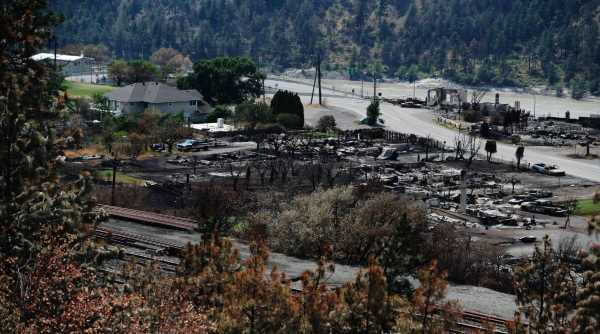Investigators are probing whether local rail traffic is responsible for starting the fire, which was exacerbated by the heat, amid temperatures that climate researchers say would virtually not be possible without human-caused global warming.
Written by Vjosa Isai
Something strange was happening to the acacia trees in Lytton, British Columbia.
The small town in western Canada had seen three days of extreme heat that each broke national temperature records by June 30, rising to 121 degrees. That morning at the Lytton Chinese History Museum, Lorna Fandrich noticed the green leaves dropping off the trees surrounding the building, she said, apparently unable to tolerate the heat.
Hours later, Lytton was on fire. A village of fewer than 300 people, nestled among mountain ranges, and prone to hot summers, the town was consumed by flames that destroyed 90% of it, killed two and injured several others, authorities said.
Investigators are probing whether local rail traffic is responsible for starting the fire, which was exacerbated by the heat, amid temperatures that climate researchers say would virtually not be possible without human-caused global warming.
On Friday, when a path was finally cleared of downed power lines, bricks and other debris to make way for five buses taking residents to tour the town, the village was almost unrecognizable, the residents said.
Mounds of warped metal and disfigured wood poked out of gutted buildings. Whatever brick walls remained were often scarred by black scorch marks.
Matilda and Peter Brown saw that their house has been destroyed, leaving just the skeleton of a traditional Indigenous hut used to air dry salmon.
“That was our home,” Matilda Brown said through tears. “That was our sanctuary. Right now we have no place.”
The extreme heat wave that blasted through much of the Pacific Northwest at the end of June spurred widespread wildfires, a drastic spike in heat-related deaths and environmental devastation that wiped out millions of coastal wildlife.
Lytton was hit particularly hard, with temperatures ranging between 116 and 121 degrees. The fire left displaced residents and neighboring Indigenous communities wondering what could be salvaged among the ashes.
“Where many buildings stood is now simply charred earth,” the village of Lytton said in a July 6 statement.
For more than a week, residents, restricted from returning to their homes, were left wondering what, if anything, of their former lives survived the fire.
Peter Brown, who is from the Lytton First Nation, lost one of the family’s heirloom cedar baskets and some personal documents, stowed away in a gun safe.
Matilda Brown is a member of the Ts’kw’aylaxw First Nation, near the neighboring town of Lillooet, where she was leading an addiction counseling group at the time of the fire. She said she is taking time away from work to tend to this “nightmare.”
“I don’t want to be a wounded healer,” she added.
A dramatic scene unfolded June 30 when “someone banged on the office windows after hours” to alert town staff members of the fire, the village statement said. The mayor ordered a complete evacuation, while volunteer firefighters attempted to tame the roaring blaze in dry conditions that allowed it to tear through the town.
At the height of the heat wave, more than 90 crew members flew to British Columbia to help the wildfire service, battling flames over thousands of acres in challenging conditions for overheating equipment. Sudden deaths also rose sharply due to the heat. Emergency responders attended 777 that were reported to the provincial coroner’s office between June 25 and July 1, more than three times the number in the same period last year.
The heat wave in Canada presented an additional public health concern as authorities were still grappling with the challenge of the coronavirus and Canadians just beginning to enjoy some of the pleasures of summer as restrictions ease.
Gordon Murray, president of the Two Rivers Farmers Market in Lytton, said feelings of grief, sorrow, anger and frustration aboard his bus Friday were “overwhelming.”
More disconcerting still was just how localized the fire was, he said. He and his partner have been living in Lytton for about a decade and could see their chimney and white fireplace from their vantage point on the bus. They also lost a cat to the fire.
“That was one of the strange things about it, is that the town is erased,” Murray said. “Literally, there’s an occasional chimney stack as a kind of exclamation point to the fact that the town is completely gone.”
Ten animal welfare workers were allowed behind the evacuation perimeter July 8 to carry out a pet and livestock rescue. Forty-one animals were saved and were being assessed before they could be reunited with their owners, said Lorie Chortyk, a spokesperson at the British Columbia Society for the Prevention of Cruelty to Animals.
Fandrich, the museum owner, opted not to join the tour, “because it’ll be very emotional, and I think we’ll just wait until they let us go down on an individual basis,” she said.
Although she is not of Chinese heritage herself, she opened the museum in 2017, modeled after a traditional temple that once existed on that land to recognize the contributions and history of Chinese workers in British Columbia. It housed more than 1,600 artifacts, books and archives — all lost in the fire. The town’s history museum also burned down.
“We’ve lost two of the core parts of our history,” Fandrich said. “So that’s all gone.”
The nearby homes of her two sons were razed. Her daughter’s coffee shop was also destroyed.
The severity of the fires that scorched close to 1.7 million acres in Canada reported by its natural resources agency occurred with temperatures that surpassed what researchers had ever seen in previous heat waves, according to a recent analysis by a team of international climate researchers.
Source: Read Full Article


